 |
 |
Семинар > Музикални инструменти |
 |
 |
 |
Български народни инструментиНа тази страница ще намерите описание на българските народни инструменти и да добиете представа за техния тембър от музикални примери. Представените музикални инструменти се изучават в ежегодния семинар за балкански народни танци и музика Балканфолк.
Кавал, гайда и гъдулка са едни от от най разпространените български народни инструменти. Някой от тях се срещат в цяла България, докато други се използват само в определени региони. Например в Родопите най-разпространеният народен музикален инструмент е гайдата (наречена още родопска или каба гайда); в Пиринския регион са най-разпространени различни видове тамбури, в Тракия - кавал, гайда, гъдулка, тъпан и т.н.
В зависимост от звукоизвличането българските народни инструменти се разделят на три групи:
1. Струнни инструменти:
- Лъкови - гъдулка;
- Дрънкови - различни видове тамбури;
2. Духови инструменти - кавал, гайда, дудук, двоянка и др.
3. Ударни инструменти - тъпан, тарамбука и др.
1. Струнни музикални инструменти |
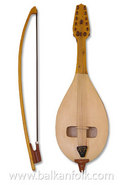 |
Лъкови: Гъдулка (копанка)
Gadoulka is a Slavonic stringed instrument without a fingerboard as it is in the current violin. Strings are not with one and the same length and the same height. The first string is the lowest, the second is longer and higher and the third is the highest. Usually gadoulkas have three of four strings. In some there are further, thinner metallic strings conforming to the tones, which are played on the instrument with fingers. The folk gadoulka player calls these strings under-sounds that make resonance. Their purpose is to resonate on tones which in the gadoulka sound more deafly and not clearly. As playing on a violin fingers press the strings against the fingerboard still in difference, playing on gadoulka without a fingerboard, fingers, instead of playing onto the strings, touch them with nails. The sonority of gadoulka in comparison, with the sonority of violin is more quiet and deafer, but more pleasant. Possibilities of tones are from "sol" on the little octave still "re" on the second octave.
Sample (32 sec.):
RealAudio (427 Kb) | Mp3 (474 Kb);
|
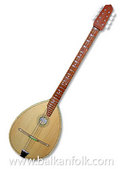 |
Дрънкови струнни инструменти: Тамбура (дранакия, дзънга, байлама)
The tamboura in comparison with the other musical folk instruments is not so diffused as gadoulka. There are tamburas with the different extent very often in the region of Raslog, Gotse Delchev and others. All tamboura's strings are metallic with one and same thickness and are puled with a plectrum, which often is called with the Turkish name "tesane". There are tambouras with two, three, six and eight strings and other with twelve. Folk orchestras are used in utilising the six-stringed tamboura, whose strings are with different thickness and are disposed in three groups too. The violin key is written with notes and has a volume from "la" on the little octave still "la" on the second octave.
Sample (20 sec.) in:
RealAudio (290 Kb) | MP3 (305 Kb);
|
2. Духови музикални инструменти |
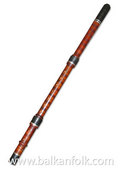 |
Кавал
The kaval is one of the most diffused musical folk instruments used very much from the Bulgarians long time ago still now. It's used in whole Bulgaria but specially in Thrace and Dobrudja. The technical construction of the kaval from all of the kinds is the same. They differ only in the length of the pipe. There are kavals with lengths of 50, 70, 75 and 80 cm. In consequence with it the kavals are with different kind of highs (different tunes). The kaval's volume of the tone is concerned with the tune.
Sample (46 sec.) in:
RealAudio (604 Kb) | MP3 (704 Kb);
|
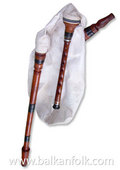 |
Гайда
The gaida is an instrument which is used from all European nations. It's composed from the following parts: gaidunitsa, ruchilo, duhalo, glavini and meh. Gaidunitsa is the most important part of the gaida and is a kind a pipe with eight holes for the fingers, seven of them which are on the front side and the eight hole is on the back side of the pipe. The tone possibilities of the gaida are poorer then these of the caval. The players are used in differing two main kind. Low (caba) and high (dzhura) - the low type of gaida is diffused in the mountain regions. In Bulgaria is popular so called Rhodopian (mountain) gaida, which is used from the accompaniment of the fine lyrical Rhodopian gaidars. The most used gaida is with the main tone "sol" (dzhura). It's with a loud tone possibilities in comparison to the other kind of gaida.
Sample (23 sec.) in:
RealAudio (49,2 Kb) | MP3 (276 Kb);
|
|
Свирка (цафара, сворче)
The shepherd's gaida called tsafara too, is a one-tubed, wooden, cylindrical tube long from 25 to 30 cm with six holes for fingers on it. The technical and the tone possibilities of the shepherd's gaida are limited. The nozzle (naustnik) and the way of blowing are the same with the way of playing on a kaval.
|
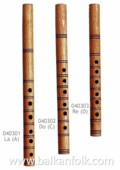 |
Дудук
The duduk's nozzle has a bill form. It's different from the little kaval and the tsafara with its construction and way of reproducing the sound. It's used mostly in west Bulgaria (rarely in other regions) usually in two extents - big and small duduk. It's made from ash-tree, cornet tree, sycamore or cherrytree.
|
|
Двоянка
It is a double pipe (gaida), which has a form of a rectangular prism or which is more rarely is composed form two parallel cylindrical tubes. It has a length from 30 to 40 cm. All of the two tubes begin with a bill formed nozzle in which the tone is produced with an ordinary blowing. When playing on a duduk the two tubes are temporary blown.
|
3. Ударни музикални инструменти |
|
The pulsate instruments which are used in the folk music are without definitive height of the tone. Most diffused are: tapan, the big drum, tarambouka, daire and others. |
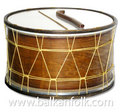 |
Тъпан
The tapan which is used in Bulgaria has elementary structure. His body and hoops are wooden and the tighten of the skins is made with strings. It has really small diameter (from 50 to 60 cm). The tapan is beaten form the one side with a big wooden kiyak and from the other side - with a thin osier, with which is played the part of the small drum, which the Bulgarians don't use in the folk music.
Sample (43 sec.) in:
RealAudio (557 Kb) | MP3 (654 Kb);
|
|
Тарамбука
Tarambouka is made from baked clay. Its form is longish with too apertures. The one is wide but the other is more narrow. On the wide aperture is stretched a leather, into which his fingers play. Sample (22 sec.) in:
RealAudio (290 Kb) | MP3 (345 Kb);
|
|
|
Добре дошли • Програма • Разписание • Преподаватели • Настаняване • Забавления • История • Цени • Регистрация
|
Публикувайте информация за фолклорни концерти, фестивали, семинари и др. в календара на Балканфолк сайт.
Добави събитие
|
|
|
 | Черкезко хоро |  | Ръка |  | Седи Донка |  | Кукуняса |  | Огражденско |
|
|